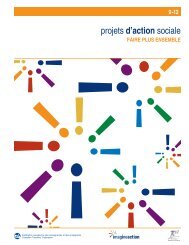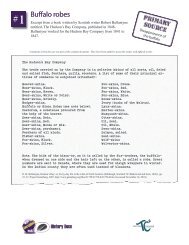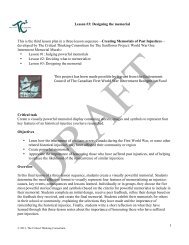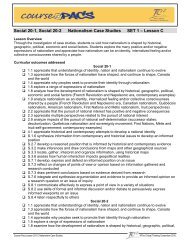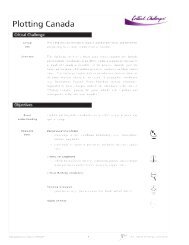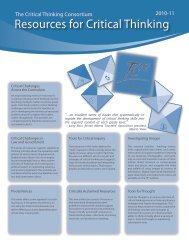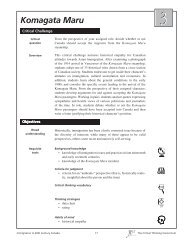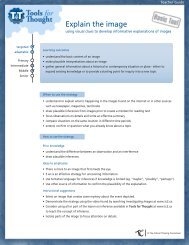Inquiry-mindedness - The Critical Thinking Consortium
Inquiry-mindedness - The Critical Thinking Consortium
Inquiry-mindedness - The Critical Thinking Consortium
Create successful ePaper yourself
Turn your PDF publications into a flip-book with our unique Google optimized e-Paper software.
TEACHER RESOURCE #4Reinforcethe strategyApply the strategy toeveryday teachingAssess use ofthe strategy➤➤➤➤➤➤➤➤➤➤Introduce Student Resource #4. Review each ofthe elements: purpose, strategies, practise sample,and self-assessment rubric. Discuss with studentswhen this strategy might be useful in both inschool and in real-life situations. Encouragestudents to refer to this resource when usingthe strategy in the future.Reinforce the strategy by asking studentsto review one or more of the followinginterviews with Greg Mortenson. Askstudents to listen to the video and assessthe responsive quality of the questionsasked by the interviewer in one of thefollowing sites:http://www.clipsyndicate.com/publish/video/697103/night_talk_an_interview_with_greg_mortenson_part_2http://www.msnbc.msn.com/id/21134540/vp/28792411#28792411(Note: a commercial precedes the interview)http://www.pbs.org/now/news/309.htmlhttp://www.youtube.com/watch?v=ilqFxkoKhnoResponsivequestioningasking questions that build on the ideas of othersTools for Thought 2008-09:3 38 © <strong>The</strong> <strong>Critical</strong> <strong>Thinking</strong> <strong>Consortium</strong>STUDENT RESOURCE #4At appropriate times over the ensuing several weeks, ask students to use this strategy in regularclassroom situations, including the following:• asking questions following a presentation;• finding out about a new person they have met;• conducting an interview;• taking part in a conversation where someone is attempting to explain something.Encourage students to refer to the rubric found in Student Resource #4 when self-assessing theiruse of this literacy strategy.• Allow students opportunities to apply the strategy two or three times without evaluation.• Guide students in interpreting and using the rubrics to assess their own responses.• Encourage students to use the rubric whenever they use this strategy.To use the rubric for teacher evaluation of student work, remove the first person (student) reference.PurposeThis strategy helps meask questions that expandmy understanding andcontribute to a discussion.For a sample use of thestrategy, see the nextpageAPPLYthe strategy• Think about the topic and write down relevant information you have.• Listen deeply and carefully to the speaker and to questions asked by others.• Record ideas that are connected with things you already know and note newideas that are presented.• Suspend any responses that attack, defend, or explain your own point ofview.• Focus on finding out more about the topic presented and uncovering whatthe speaker thinks. What are you curious about? What is unclear? Brainstormpossible questions that extend your understanding and perhaps create newunderstanding.• Consider which questions build on previous information, seek new understanding,and require thought to answer as you select the best questions to ask.Assessing my ability to use “Responsive questioning”Accomplished Good Basic StrugglingConnecting with the speaker:I listen intently and I listen carefully to the I listen carefully to the I make very fewgenuinely want to presentation and can speaker but sometimes connections with the topicounderstand theidentify some important my mind wanders or presented. It is usually hardspeaker. I can identify points that connect with I just react instead of for me to focus on themany relevant points things I know.wanting to understand the speaker and most of thein a presentation orspeaker. I can make some time I find it hard to figureconversation that connectconnections and think of out what is important.to things I already knowquestions to ask but I amand make me curious tonot sure I always focus onlearn more.what is important.<strong>The</strong> questions I ask add to Most of my questions I can think of questions to <strong>The</strong> questions I ask arethe information I already build on the ideas ask but they do not always usually not connected tohave and extend the presented and often new lead to the development what has come beforespeaker’s ideas and other ideas emerge.of new ideas.and do not lead to furtherpeople’s comments. <strong>The</strong>conversation or ideas.questions I ask contributeto developing new ideas.Creating responsive questions:References➤ ➤ Mortenson Greg, & Relin, David Oliver. 2006. Three Cups of Tea. New York: Penguin.➤➤➤ ➤Mortenson Greg, & Relin, David Oliver. 2009. Three Cups of Tea: <strong>The</strong> Young Readers Edition.New York: Penguin.Mortenson Greg, & Roth, Susan. 2009. “Listen to the Wind” <strong>The</strong> Story of Dr Greg & Three Cupsof Tea. New York: Penguin.Tools for Thought 2008–09:3 33 © <strong>The</strong> <strong>Critical</strong> <strong>Thinking</strong> <strong>Consortium</strong>



